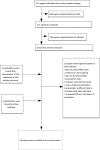Premenstrual syndrome and alcohol consumption: a systematic review and meta-analysis
- PMID: 29661913
- PMCID: PMC5905748
- DOI: 10.1136/bmjopen-2017-019490
Premenstrual syndrome and alcohol consumption: a systematic review and meta-analysis
Abstract
Objective: Premenstrual syndrome (PMS) is a very common disorder worldwide which carries an important economic burden. We conducted a systematic review and a meta-analysis to assess the role of alcohol in the occurrence of PMS.
Methods: We searched MEDLINE, EMBASE, the five regional bibliographic databases of the WHO, the Proceedings database and the Open Access Thesis and Dissertations (OATD) from inception to May 2017. We also reviewed the references of every article retrieved and established personal contact with researchers to trace further publications or reports. We did not include any language limitations. Studies were included if: (1) they presented original data from cohort, case-control or cross-sectional studies, (2) PMS was clearly defined as the outcome of interest, (3) one of the exposure factors was alcohol consumption, (4) they provided estimates of odds ratios, relative risks, or any other effect measure and their confidence intervals, or enough data to calculate them.
Results: We identified 39 studies of which 19 were eligible. Intake of alcohol was associated with a moderate increase in the risk of PMS (OR=1.45, 95% CI: 1.17 to 1.79). Heavy drinking yielded a larger increase in the risk than any drinking (OR=1.79, 95% CI: 1.39 to 2.32).
Discussion: Our results suggest that alcohol intake presents a moderate association with PMS risk. Future studies should avoid cross-sectional designs and focus on determining whether there is a threshold of alcohol intake under which the harmful effect on PMS is non-existent.
Keywords: alcohol; meta-analysis; premenstrual syndrome.
© Article author(s) (or their employer(s) unless otherwise stated in the text of the article) 2018. All rights reserved. No commercial use is permitted unless otherwise expressly granted.
Conflict of interest statement
Competing interests: None declared.
Figures




References
-
- Sternfeld B, Swindle R, Chawla A, et al. . Severity of premenstrual symptoms in a health maintenance organization population. Obstet Gynecol 2002;99:1014–24. - PubMed
-
- Borenstein JE, Dean BB, Endicott J, et al. . Health and economic impact of the premenstrual syndrome. J Reprod Med 2003;48:515–24. - PubMed
Publication types
MeSH terms
Grants and funding
LinkOut - more resources
Full Text Sources
Other Literature Sources
Medical
